

Alexandra Schmidt. Music of Germany. Ludwig van Beethoven. Ludwig van Beethoven ( i/ˈlʊdvɪɡ væn ˈbeɪ.toʊvən/; German: [ˈluːtvɪç fan ˈbeːt.hoːfən] ( Born in Bonn, then the capital of the Electorate of Cologne and part of the Holy Roman Empire, Beethoven displayed his musical talents at an early age and was taught by his father Johann van Beethoven and Christian Gottlob Neefe.
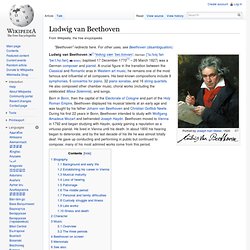
During his first 22 years in Bonn, Beethoven intended to study with Wolfgang Amadeus Mozart and befriended Joseph Haydn. Beethoven moved to Vienna in 1792 and began studying with Haydn, quickly gaining a reputation as a virtuoso pianist. He lived in Vienna until his death. Biography. Scheitholt. A scheitholt The scheitholt or scheitholz is a traditional German stringed instrument and an ancestor of the modern zither.
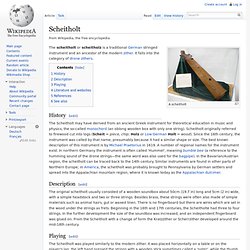
It falls into the category of drone zithers. History[edit] The Scheitholt may have derived from an ancient Greek instrument for theoretical education in music and physics, the so-called monochord (an oblong wooden box with only one string). Scheitholt originally referred to firewood cut into logs (Scheit = piece, chip; Holz or Low German Holt = wood). Klezmer Music. Klez·mer [klez-mer] Klezmer. Klezmer (Yiddish: כליזמר or קלעזמער (klezmer), pl.: כליזמרים (klezmorim), כליזמר from Hebrew: כלי זמר — instruments of music) is a musical tradition of the Ashkenazi Jews of Eastern Europe.
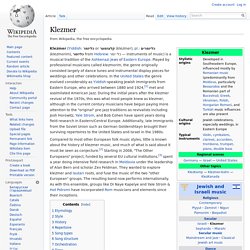
Played by professional musicians called klezmorim, the genre originally consisted largely of dance tunes and instrumental display pieces for weddings and other celebrations. In the United States the genre evolved considerably as Yiddish-speaking Jewish immigrants from Eastern Europe, who arrived between 1880 and 1924,[1] met and assimilated American jazz. During the initial years after the klezmer revival of the 1970s, this was what most people knew as klezmer, although in the current century musicians have begun paying more attention to the "original" pre-jazz traditions as revivalists including Josh Horowitz, Yale Strom, and Bob Cohen have spent years doing field research in Eastern/Central Europe.
Etymology[edit] Cimbalom. The cimbalom is a concert hammered dulcimer: a type of chordophone composed of a large, trapezoidal box with metal strings stretched across its top.

It is a musical instrument popularized in Hungary and commonly found throughout the group of Central-Eastern European nations and cultures which composed Austria-Hungary (1867–1918), namely contemporary Belarus, Hungary, Romania, Moldova, Ukraine, Poland, the Czech Republic and Slovakia. It is also very popular in Greece. The cimbalom is (typically) played by striking two beaters against the strings. Music: Oliver Shanti and Friends. Music of Indonesia. The music of Indonesia demonstrates its cultural diversity, the local musical creativity, as well as subsequent foreign musical influences that shaped contemporary music scenes of Indonesia.
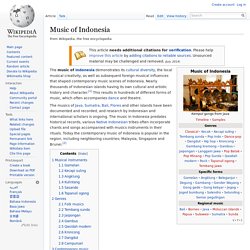
Nearly thousands of Indonesian islands having its own cultural and artistic history and character.[1] This results in hundreds of different forms of music, which often accompanies dance and theatre. Musical instruments[edit] Balinese gamelan performance. SambaSunda music performance, featuring traditional Sundanese music instruments such as kecapi, suling, and kendang. Kendang. Kendang of Bali, note the equal size of both sides.

The drum in this picture is exceptional - usually Balinese kendangs are conical (actually hour-glass formed on the inside). Overview[edit] Kendang players (top row) depicted on Borobudur. The typical double-sided membrane drums are known throughout Maritime Southeast Asia and India. Soshu Serenade [Japanese classic serenade] - Sayuri Ishikawa. Encyclopedia Britannica. SAKURA SAKURA Koto traditional Japanese instrument. Shirotomo Aizawa. Celtic music. Celtic music. Celtic music is a broad grouping of musical genres that evolved out of the folk musical traditions of the Celtic people of Western Europe.[1][2] It refers to both orally-transmitted traditional music and recorded music and the styles vary considerably to include everything from "trad" (traditional) music to a wide range of hybrids.

Often the melodic line moves up and down the primary chords in so many songs. There are a number of possible reasons for this: Melodic variation can be easily introduced. These two latter usage patterns may simply be remnants of formerly widespread melodic practices. Often, the term Celtic music is applied to the music of Ireland and Scotland because both lands have produced well-known distinctive styles which actually have genuine commonality and clear mutual influences. The definition is further complicated by the fact that Irish independence has allowed Ireland to promote 'Celtic' music as a specifically Irish product. Irish flute. The term Irish Flute (Irish: fliúít Gaelach) or "Scottish Flute" (in a Scottish setting)[1] refers to a conical-bore, simple-system wooden flute of the type favoured by classical flautists of the early 19th century, or to a flute of modern manufacture derived from this design (often with modifications to optimize its use in Irish Traditional Music or Scottish Traditional Music[1]).
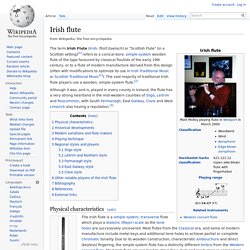
The vast majority of traditional Irish flute players use a wooden, simple-system flute.[2] Although it was, and is, played in every county in Ireland, the flute has a very strong heartland in the mid-western counties of Sligo, Leitrim and Roscommon, with South Fermanagh, East Galway, Clare and West Limerick also having a reputation.[3] §Physical characteristics[edit] The flute has six main finger-holes. For a D flute (the most common variety), with X symbolizing a covered finger-hole and O symbolizing an uncovered finger-hole, all holes covered, (three fingers per hand) can be represented as XXX-XXX = D .
Rolls. Celtic Woman. Albums[edit] The release of the second album, Celtic Woman: A Christmas Celebration, on 19 October 2006 knocked their first album to the #2 spot on the World Music chart.[9] In preparation for their third studio album, Celtic Woman performed at Slane Castle in County Meath, Ireland, on 23 and 24 August 2006, with this show airing on PBS during December 2006.

The studio album, titled Celtic Woman: A New Journey, was released on 30 January 2007. As with their debut, the live performance was released on DVD simultaneously. This album immediately hit the Billboard 200 at #4[10] and the Billboard World Music chart at #1,[11] moving their previous two releases down a notch and securing the top three positions on that chart for the group. A fourth album, Celtic Woman: The Greatest Journey, was released in 28 October 2008. On October 9, 2012, the group released its second worldwide Christmas album "Home for Christmas". Tours[edit]
African Music. African Music - Music of Africa. By Espie Estrella African Music Africa is a continent where a rich and diverse cultural heritage exists; hundreds of different languages are spoken in Africa.

During the 7th century, Arabs reached North Africa and influenced the existing culture. This is why African and Arab music share a certain degree of similarity and this extends to some musical instruments as well. Instruments Used in African Music. Souad Massi. Souad Massi (سعاد ماسي), born August 23, 1972, is an Algerian singer, songwriter and guitarist. She began her career performing in the Kabyle political rock band Atakor, before leaving the country following a series of death threats. In 1999, Massi performed at the Femmes d'Algerie concert in Paris, which led to a recording contract with Island Records. Massi's music, which prominently features the acoustic guitar, displays Western musical style influences such as rock, country or the Portuguese fado but sometimes incorporates oriental musical influences and oriental instruments like the oud as well as African musical stylings.